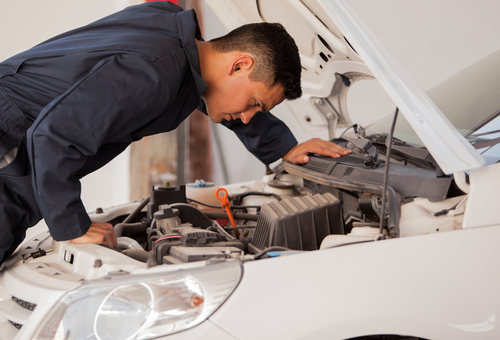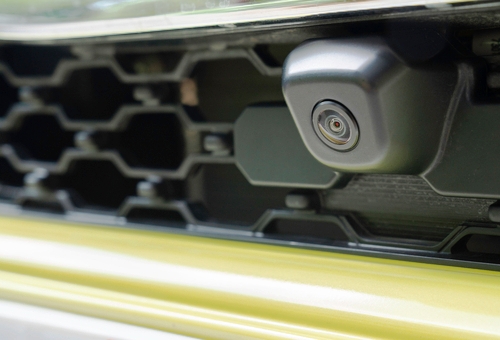
What does the expression on the face of the female customer in this image convey to you? If you are a veteran of the car repair industry, you have no doubt seen expressions like the one on this unhappy customers' face many times before, and for a variety of reasons, too. However, if you are new to the car repair industry and like this hapless young mechanic, have not had many personal interactions with customers, you should know that facial expressions like the one shown here are fairly common when you tell customers that they have to take their vehicles elsewhere because you can't repair them.
This being the case, we will use this opportunity to discuss ways and means of avoiding making customers unhappy while keeping their often very profitable work in your own bay, at the same time. Let us start with making the seemingly counter-intuitive statement that-
As a general rule, customers neither like, nor appreciate being told that you can’t repair their vehicles. They typically don’t see it as any of their problem that you don’t have the required tools, software, diagnostic computers, skills, knowledge/technical information, or anything else you may need to fix their cars, even though you may not have the required skill(s), knowledge, or equipment for perfectly legitimate reasons.
Many times though, the question of whether or not to refer a customer to another establishment comes down to having to choose the lesser of two evils. One such evil is an unhappy customer, and the other might be a long, drawn-out diagnostic nightmare that could turn into a bottomless money pit in less time than it takes to make a wrong diagnosis or draw the wrong conclusion from test results. The fact is however that referring a vehicle to a dealership or other specialist repairer is often the right thing to do because it best serves the customer’s interests, but that is a topic for another time. For the moment, we are discussing ways to keep work in your own bay, which is more important than you might think in today’s very competitive job market.
Let us put this into some sort of perspective. It had been this writer's experience as an employer that many technicians and particularly young and relatively inexperienced technicians are sometimes too quick to recommend that a vehicle be referred to a dealership or other specialist repairer. Reasons for this typically varied from (among others), “It’s too complicated”, to “We don’t have the tools”, to “We don’t understand how this, that, or the next system works”, to “We don’t have the latest service information”.
Some of these are excellent reasons to refer a vehicle, but then again, these reasons often do not apply because the problem that brought the customer to your workshop does not always require specialist-level knowledge of this, that, or the next system. Nor does the problem always require special tools or advanced service information and more often than not, the problem is not as complex as you might have thought.
Of course, you never know what you might be dealing with unless you inspect the vehicle and it is at this point that many technicians might make the wrong choice. However, there is a way or method to avoid making a potentially wrong decision prematurely- a method that this writer calls-

Sometimes the old tricks are still the best, even on late-model, high-end vehicles. For instance, burnt, shorted, disconnected, and corroded wiring looks just as it always did and a modern petrol engine still will not start an/or run properly if fuel does not reach the cylinders, if ignition sparks are not generated and/or delivered to the sparkplugs at the right moment, or if cylinder compression is lost for some reason.
Of course, this is an oversimplification, but the truth is that a simple preliminary eyeball inspection of a vehicle will often turn up evidence of burnt or damaged wiring, or leaks in fuel, oil, cooling, and brake systems- all of which have the potential to set trouble codes, initiate limp modes or even immobilize vehicles. Similarly, mechanical sounds and noises will almost always help you pinpoint and/or identify specific issues in engines, transmissions, diffs, and other rotating or reciprocating mechanical systems/components.
However, while you might strike it lucky and spot a bunch of burnt wires the moment you open the bonnet, other problems might not be that easy to spot, which is why it helps to know how modern vehicles are constructed and how everyday use of a vehicle can sometimes affect some systems and/or components. Let us look at a few examples from this writer’s own collection of practical examples of apparently serious issues that can have mundane causes, starting with-
While saying that the correct operation of modern vehicles depends almost entirely on the health and state of charge of modern vehicles’ batteries might be preaching to the choir, the fact is that this critically important preliminary check is often ignored or forgotten in the rush to identify the cause(s) of many electrical problems on modern vehicles.
However, just checking and verifying the battery’s state of charge is not enough because while many electrical issues can stem directly from voltage differences of one volt and less between the specified and actual system voltage, many other issues are directly related to poor battery maintenance practices. There are however too many possible problems related to battery issues to list here, but at a minimum, a preliminary inspection of a vehicle's electrical system should include obtaining answers to the following questions-
There are many other possible questions you could ask yourself and your customer, but the above examples should illustrate the point that asking the right questions at the right time could yield valuable diagnostic clues and information. Of course, some customers might not necessarily know the answers to some questions, but that is not as important as you, an experienced technician, asking relevant and pertinent questions. The answers to some questions might not only surprise you: they could also supply the solution(s) to electrical issues you might be tempted to refer to a dealership or competing workshop, which brings us to-

This image shows a close-up view of a forward-looking optical camera mounted in the grille of a late model vehicle, and as an experienced technician, you have no doubt seen many such cameras. However, if you are new to the car repair industry, you may not realise that other types of ADAS devices, such as for instance, radar transmitters and/or receivers, are as likely as not mounted behind bumpers or emblems, badges, or other decorative details on grilles where you can’t see them.
There are many excellent reasons why car manufacturers want to make these devices as unobtrusive as possible, but we do not need to discuss them here. Nonetheless, from our point of view as technicians, the problems with making some ADAS devices invisible is that-
Of course, we know all of the above. Nevertheless, what do we tell a customer who complains that several of the safety systems on his high-end vehicle had suddenly stopped working and that several warning lights are now flashing or blinking on the dashboard? In this writer’s experience, many technicians and/or service writers might immediately refer the customer to a dealership at this point without even looking at the vehicle, which does not help the customer at all.
Doing this may be a justified response in some cases, such as when there is visible or even suspected damage to body panels, bumpers, grilles, and/or the windscreen that might require body repairs and/or a windscreen replacement followed by extensive recalibration of several, if not all ADAS systems.
However, a preliminary inspection might also reveal road grime, dust, dirt, mud, and salt deposits (in coastal areas) obscuring a camera’s view, and in such a case, the problem could be resolved by simply cleaning off the dirt. Similarly, a preliminary inspection of the vehicle interior might reveal-
* This once happened with this writer’s own vehicle after a fishing trip. Removing a small fishhook from a seat belt switch extinguished an SRS warning light and restored the operation of the seat belt warning chime.
Depending on both what you find, and the nature of the problem, some of these issues might be easily repairable but you will never know which are repairable and which are not unless you perform a thorough visual inspection of the vehicle’s interior, which leaves us with-
Many, if not most drivability issues stem directly from electrical problems, but before you plug in a scan tool you might want to perform a visual inspection of the vehicle, and particularly of the wiring that you can easily access.
However, much of how you proceed from this point onwards depends on the customers’ concerns. For instance, the customer might complain of things like intermittent no-start conditions, low or erratic idling speeds, unpredictable engine stalling, poor engine performance, or excessive fuel consumption that started suddenly, and in these cases, the cause(s) often involve poor electrical connections.
While these kinds of issues are usually our stock-in-trade (in a manner of speaking), a quick visual inspection of the vehicle will often reveal the source of the problem without the need to spend an hour or more scanning all the control modules on the vehicle for trouble codes. If an inspection does not reveal obvious evidence of wiring issues you might have to use a san tool to extract codes, but if you are not experienced in electrical diagnostics, you can save a lot of time by NOT doing the following-
Moreover, many electrical issues that cause drivability problems are the direct result of sloppy workmanship during previous repairs, so you could continue your inspection by testing connectors to see if all are properly connected, engaged, and locked. Other things you might want to inspect could include the following-
The few pointers outlined in this article represent only the proverbial tip of an iceberg-sized mountain of data that can be obtained simply by performing preliminary inspections of vehicles that many technicians and/or service writers often refer to dealerships or competing workshops. For instance, we have not discussed looking for mismatched or unsuitable control modules installed by DIY mechanics, or the possible effects of missed programming updates, fixes, and patches on ECU programming. Nor have we discussed the importance of identifying junction boxes and other devices that link electrical circuits, the difference(s) between global scan tool data and vehicle-specific diagnostic data, or the importance of using engine oil with the correct grade, formulation, and viscosity.
There are many other examples we could list here, but the point is this: performing repairs based solely on fault code definitions is not a good idea because this often only masks or fixes the symptoms of trouble codes temporarily, without addressing the underlying root cause(s) that had set the codes. Thus, performing a thorough preliminary inspection allows you get a holistic view of a vehicle’s overall condition, its state of repair, and perhaps more importantly, of the amount of money the vehicles' owner has spent or is prepared to spend on its upkeep.
All of the above represents knowledge you can use to learn the fine art of keeping a vehicle in your bay, instead of in the bays of competing workshops. This is something your employer is bound to notice sooner than you might think, and that can never be a bad thing.